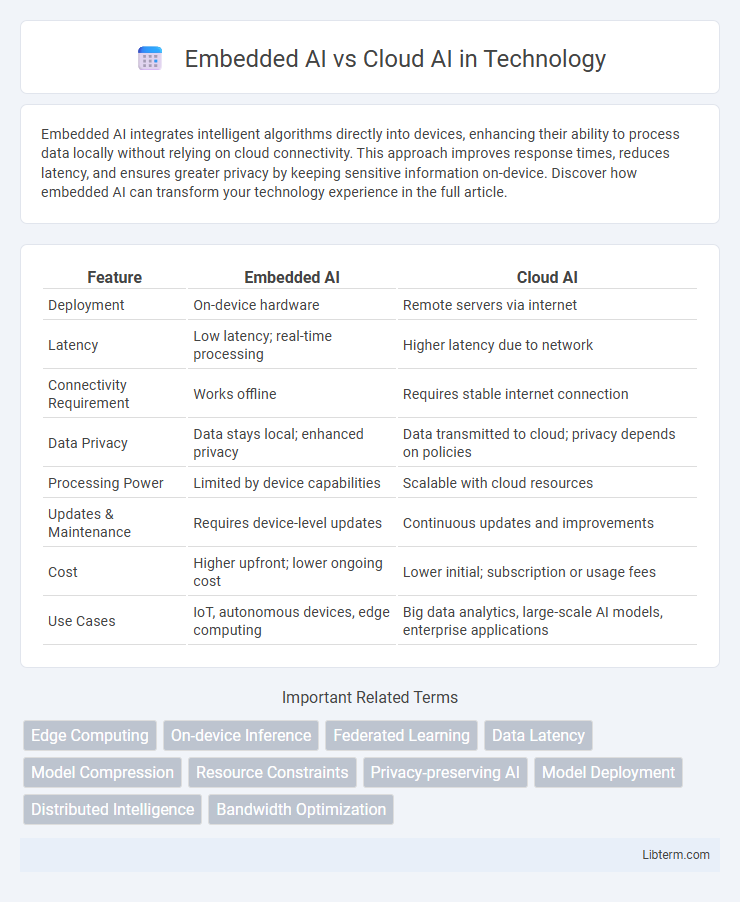Embedded AI integrates intelligent algorithms directly into devices, enhancing their ability to process data locally without relying on cloud connectivity. This approach improves response times, reduces latency, and ensures greater privacy by keeping sensitive information on-device. Discover how embedded AI can transform your technology experience in the full article.
Table of Comparison
| Feature | Embedded AI | Cloud AI |
|---|---|---|
| Deployment | On-device hardware | Remote servers via internet |
| Latency | Low latency; real-time processing | Higher latency due to network |
| Connectivity Requirement | Works offline | Requires stable internet connection |
| Data Privacy | Data stays local; enhanced privacy | Data transmitted to cloud; privacy depends on policies |
| Processing Power | Limited by device capabilities | Scalable with cloud resources |
| Updates & Maintenance | Requires device-level updates | Continuous updates and improvements |
| Cost | Higher upfront; lower ongoing cost | Lower initial; subscription or usage fees |
| Use Cases | IoT, autonomous devices, edge computing | Big data analytics, large-scale AI models, enterprise applications |
Introduction to Embedded AI and Cloud AI
Embedded AI integrates artificial intelligence directly into hardware devices, enabling real-time data processing and low-latency decision-making at the edge. Cloud AI leverages powerful centralized servers to perform complex computations and large-scale data analysis, offering scalability and access to vast datasets. The choice between Embedded AI and Cloud AI depends on factors such as latency requirements, connectivity, data privacy, and computational resources.
Key Differences Between Embedded AI and Cloud AI
Embedded AI processes data locally on devices, enabling real-time decision-making with low latency and enhanced privacy. Cloud AI leverages powerful remote servers for complex data analysis and large-scale model training but depends on stable internet connectivity. The main differences lie in processing location, latency, data privacy, and dependency on network infrastructure.
Architecture Overview: Embedded vs Cloud AI
Embedded AI integrates machine learning models directly into devices, enabling real-time data processing with low latency and minimal dependence on internet connectivity. Cloud AI relies on centralized servers and vast computational resources, offering scalable processing power and access to extensive datasets for model training and inference. The architectural distinction centers on proximity to data sources, with embedded AI prioritizing edge computing efficiency and cloud AI emphasizing resource-intensive, scalable analytics.
Performance and Latency Considerations
Embedded AI processes data locally on devices such as smartphones or IoT sensors, significantly reducing latency by eliminating the need for constant cloud communication and enabling real-time decision-making. Cloud AI leverages powerful centralized servers to handle complex computations and large datasets but often experiences higher latency due to network transmission delays, impacting time-sensitive applications. Performance in embedded AI is optimized for low-power devices with limited resources, whereas cloud AI excels in scalability and processing capacity for intensive tasks.
Data Privacy and Security Implications
Embedded AI processes data locally on devices, significantly reducing exposure to external networks and minimizing risks of data breaches, ensuring enhanced privacy and security for sensitive information. Cloud AI relies on transmitting data to centralized servers, increasing vulnerability to cyberattacks and necessitating robust encryption and compliance with data protection regulations like GDPR and HIPAA. Organizations must weigh the trade-offs between the immediacy and convenience of cloud processing against the tighter control over data inherent in embedded AI systems.
Scalability and Flexibility of Deployment
Embedded AI offers superior real-time processing and low-latency responses by running directly on local devices, ensuring high scalability in environments with limited or intermittent connectivity. Cloud AI provides exceptional flexibility in deployment by leveraging vast computational resources and scalable infrastructure, enabling dynamic adaptation to varying workloads and centralized model updates. Choosing between Embedded AI and Cloud AI depends on specific scalability needs and deployment environments, with Embedded AI favoring edge efficiency and Cloud AI excelling in expansive, resource-demanding applications.
Cost Analysis: Embedded AI vs Cloud AI
Embedded AI reduces operational costs by processing data locally, minimizing cloud service fees and data transmission expenses, while Cloud AI incurs ongoing costs related to data storage, bandwidth, and scalable computing resources. Initial hardware investment for Embedded AI can be higher due to specialized edge devices, but long-term savings arise from decreased latency and reduced dependence on continuous internet connectivity. Cloud AI offers flexible pay-as-you-go pricing models that are beneficial for dynamic workloads but can significantly increase expenses as usage scales.
Use Cases for Embedded AI
Embedded AI powers real-time decision-making in autonomous vehicles by processing sensor data locally, ensuring low latency and enhanced safety. It enables smart home devices, like thermostats and security cameras, to operate efficiently without relying on constant internet connectivity. Industrial automation benefits from Embedded AI through predictive maintenance and quality control performed directly on machinery, reducing downtime and operational costs.
Use Cases for Cloud AI
Cloud AI excels in large-scale data processing tasks such as real-time analytics, natural language processing, and image recognition, supported by vast computational resources and storage capacity. Use cases include customer service chatbots, personalized marketing campaigns, and fraud detection systems that leverage cloud-based machine learning models for continuous learning and adaptation. Enterprises benefit from Cloud AI by deploying scalable AI solutions that integrate seamlessly with existing cloud infrastructures, enabling efficient data access and collaborative workflows.
Choosing the Right Approach for Your Application
Embedded AI enables real-time processing and low-latency responses by running machine learning models directly on devices, making it ideal for applications requiring immediate decision-making and offline functionality. Cloud AI offers scalable computing power and extensive data storage, supporting complex analytics and continuous model updates, which suits applications with large datasets and dynamic environments. Selecting the right approach depends on factors such as latency requirements, data privacy concerns, computational resources, and connectivity availability.
Embedded AI Infographic

 libterm.com
libterm.com